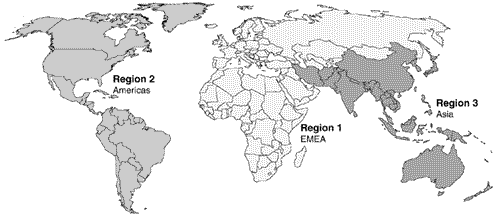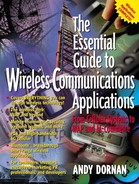Spectrum Regulation
Because radio communication depends on a clear channel, free of interference, spectrum has to be strictly rationed. Much of this rationing is handled by national regulators such as the FCC (Federal Communications Commission) in the United States, but there is an increasing trend towards international cooperation. This is needed both to handle the long-range frequencies that can spread across international boundaries and to promote compatibility between systems in different countries.
ITU
The international body responsible for radio spectrum is the ITU (International Telecommunications Union). Though an agency of the United Nations, it actually predates the parent organization by nearly a century. It was founded in 1865 to handle interconnection between the national telegraph networks, and has managed radio spectrum since 1906. Its mandate covers all kinds of radio services, from broadcast television to satellite phones.
For spectrum purposes, the ITU divides the world into three regions, shown on the map in Figure 2.9. Though some services, such as communications satellites, do need to use the same spectrum throughout the world, historical and political differences mean that others cannot. For example, the U.S. allows more AM radio stations in the MW band than does Europe. They roughly correspond to Europe, the Middle East, and Africa in the first, America in the second, and Asia in the third. Because they were defined during the d War, Europe is taken to include the entire former Soviet Union.
Every two to three years, the ITU holds a WRC (World Radiocommunication Conference), a four-week summit to discuss how radio spectrum is assigned. Though mostly dominated by government and industry, other interest groups, such as scientists and radio hams, are also represented. Its official remit is to discuss more efficient ways to use the available frequencies, but economic and social factors also come into play.
A current example is the analog television system, which occupies a vast swathe of the UHF band and uses obsolete technology developed in the 1950s. Governments and wireless operators would love to use this spectrum for new advanced data services, but can't because they fear a backlash from TV viewers. For example, the UK has committed itself to shutting down all analog TV stations, but not until 90 percent of its population have a digital set.
The U.S. has more spectrum allocated to television than most other countries, so the FCC has pressed ahead with selling some of it off to mobile operators. The first chunk in the 700 MHz band, representing channels 60 to 69, was supposed to be auctioned in 2000. However, many operators were put off applying, thanks to the requirement that they would have to share the frequencies with TV for a transition period. On their request, the sale was postponed until 2001 so that they would have a chance to develop business plans.
At the WRC-2000, the main topic of discussion was the new generation of broadband wireless technologies, lectively known as IMT (International Mobile Telecommunications) 2000. Other issues discussed included
Global satellite systems, such as Teledesic and Globalstar, which require frequency allocation all over the world.
Broadband fixed wireless technologies, such as LMDS (Local Multipoint Distribution System), which can compete with wired local loop services, but are held back in many countries by slow licensing procedures.
Concerns of astronomers and alien-hunters that the boom in wireless communications will drown signals from outer space.
Figure 2.9. ITU regions

Regional Licenses
Most regulators issue licenses on a nationwide basis, allowing (and often requiring) every operator to build a network that spans the entire country. The exception is the U.S., which is so big that only very large carriers would be able to build a nationwide network. Instead, the FCC divides it into several regions, which differ depending on the type of service being licensed.
MSA (Metropolitan Service Area) and RSA (Rural Service Area) were defined for analog cellular licenses. There were 305 MSAs and 429 RSAs, with two competing operators allowed in each. This gives a total of 1,468 separate licenses, most of which eventually found their way to the local fixed phone companies.
BTA (Basic Trading Area) replaced the old MSAs and RSAs in the 1990s, though analog services continue to follow the old boundaries. There are a total of 493 BTAs, originally based on where residents did their shopping, so they tend to be centered around towns and malls. Four digital cellular licenses were issued in each, and they continue to be used for licensing almost all new spectrum.
MTA (Major Trading Area) is a group of BTAs. There are only 51 of these, and some span many small states. Another two digital cellular licenses were issued in each, aimed at operators who wanted a wide coverage area without having to lect lots of smaller licenses separately.
Service Specific vs. Open Licenses
Below the level of global cooperation aimed at by the WRC, many countries also laborate in smaller regional groups. The most influential is the EU (European Union), which frequently issues legally binding directives ordering its 15 member states to license particular spectrum for certain services. In contrast, the FCC allows U.S. operators freedom to deploy whatever technology they like.
The EU's mandated technologies are usually those devised by ETSI (European Telecommunications Standards Institute), a wider group that includes representatives from major companies doing business in Europe. Their greatest success so far is GSM (Global System for Mobile Communications, explained fully in Chapter 4, "PCS Standards" ). It was originally devised in 1982 by CEPT (Conference Européenne des Administrations des Postes et Telecommunications), a government body now largely superseded by ETSI. The standard was expandable enough to be used as the basis for advanced Internet services, yet simple enough to be deployed throughout Europe. It later grew way beyond, to become the world's most popular telecom system; in 1999, GSM networks were growing by a million new subscribers each week.
GSM's critics say that its dominance is due to government interference, not technical superiority: when European governments licensed mobile phone spectrum, they insisted that every operator deploy a GSM. American companies accused the EU of protectionism because GSM systems tended to be made by European manufacturers such as Nokia and Ericsson. In particular, Qualcomm said that its CDMA (Code Division Multiple Access) technology, described in Chapter 3, "Cellular Networks," was being kept out unfairly.
Protectionist or not, Europe's policies gave it a seamless, continent-wide, mobile network, compared to a mess of incompatible systems in the U.S. Preventing competition between technologies also helped to promote competition between manufacturers, and later operators—if they're all offering the same kind of equipment and services, it's easier to compare prices.
Most countries worldwide are now following the European lead, not just in using GSM, but in licensing service-specific frequencies. Many have already earmarked a 155 MHz slice of spectrum in the 2000 MHz region for third-generation mobile data, and are making licenses conditional on deploying specific technologies and fulfilling service obligations.
